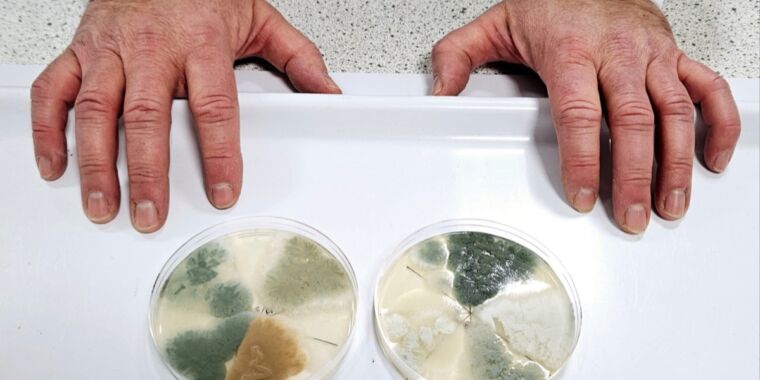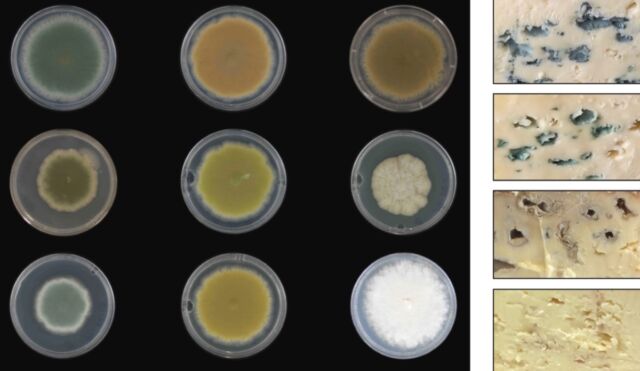Blue cheese shows off new colors, but the taste largely remains the same


University of Nottingham
Gourmands are well aware of the many varieties of blue cheese, known by the blue-green veins that ripple through the cheese. Different kinds of blue cheese have distinctive flavor profiles: they can be mild or strong, sweet or salty, for example. Soon we might be able to buy blue cheeses that belie the name and sport veins of different colors: perhaps yellow-green, reddish-brown-pink, or lighter/darker shades of blue, according to a recent paper published in the journal Science of Food.
“We’ve been interested in cheese fungi for over 10 years, and traditionally when you develop mould-ripened cheeses, you get blue cheeses such as Stilton, Roquefort, and Gorgonzola, which use fixed strains of fungi that are blue-green in color,” said co-author Paul Dyer of the University of Nottingham of this latest research. “We wanted to see if we could develop new strains with new flavors and appearances.”
Blue cheese has been around for a very long time. Legend has it that a young boy left his bread and ewe’s milk cheese in a nearby cave to pursue a lovely young lady he’d spotted in the distance. Months later, he came back to the cave and found it had molded into Roquefort. It’s a fanciful tale, but scholars think the basic idea is sound: people used to store cheeses in caves because their temperature and moisture levels were especially hospitable to harmless molds. That was bolstered by a 2021 analysis of paleofeces that found evidence that Iron Age salt miners in Hallstatt (Austria) between 800 and 400 BCE were already eating blue cheese and quaffing beer.

The manufacturing process for blue cheese is largely the same as for any cheese, with a few crucial additional steps. It requires cultivation of Penicillium roqueforti, a mold that thrives on exposure to oxygen. The P. roqueforti is added to the cheese, sometimes before curds form and sometimes mixed in with curds after they form. The cheese is then aged in a temperature-controlled environment. Lactic acid bacteria trigger the initial fermentation but eventually die off, and the P. roqueforti take over as secondary fermenters. Piercing the curds forms air tunnels in the cheese, and the mold grows along those surfaces to produce blue cheese’s signature veining.
Once scientists published the complete genome for P. roqueforti, it opened up opportunities for studying this blue cheese fungus, per Dyer et al. Different strains “can have different colony cultures and textures, with commercial strains being sold partly on the basis of color development,” they wrote. This coloration comes from pigments in the coatings of the spores that form as the colony grows. Dyer and his co-authors set out to determine the genetic basis of this pigment formation in the hopes of producing altered strains with different spore coat colors.
The team identified a specific biochemical pathway, beginning with a white color that gradually goes from yellow-green, red-brown-pink, dark brown, light blue, and ultimately that iconic dark blue-green. They used targeted gene deletion to block pigment biosynthesis genes at various points in this pathway. This altered the spore color, providing a proof of principle without adversely affecting the production of flavor volatiles and levels of secondary metabolites called mycotoxins. (The latter are present in low enough concentrations in blue cheese so as not to be a health risk for humans, and the team wanted to ensure those concentrations remained low.)

University of Nottingham
However, food industry regulations prohibit gene-deletion fungal strains for commercial cheese production. So Dyer et al. used UV mutagenesis—essentially “inducing sexual reproduction in the fungus,” per Dyer—to produce non-GMO mutant strains of the fungi to create “blue” cheeses of different colors, without increasing mycotoxin levels or impacting the volatile compounds responsible for flavor.
“The interesting part was that once we went on to make some cheese, we then did some taste trials with volunteers from across the wider university, and we found that when people were trying the lighter colored strains they thought they tasted more mild,” said Dyer. “Whereas they thought the darker strain had a more intense flavor. Similarly, with the more reddish-brown and a light green one, people thought they had a fruity, tangy element to them—whereas, according to the lab instruments, they were very similar in flavor. This shows that people do perceive taste not only from what they taste but also by what they see.”
Dyer’s team is hoping to work with local cheese makers in Nottingham and Scotland, setting up a spinoff company in hopes of commercializing the mutant strains. And there could be other modifications on the horizon. “Producers could almost dial up their list of desirable characteristics—more or less color, faster or slower growth rate, acidity differences,” Donald Glover of the University of Queensland in Australia, who was not involved in the research, told New Scientist.
Science of Food, 2024. DOI: 10.1038/s41538-023-00244-9 (About DOIs).
Source link




